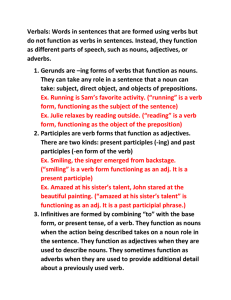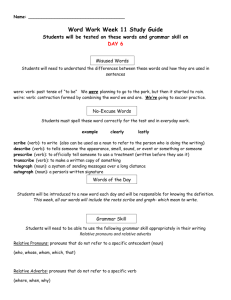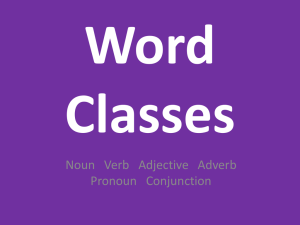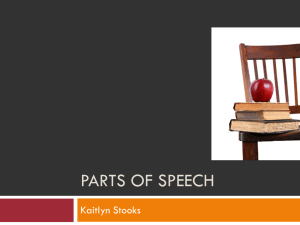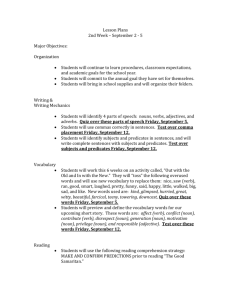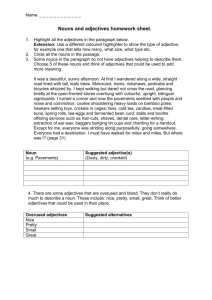Identifying Parts of Speech
advertisement
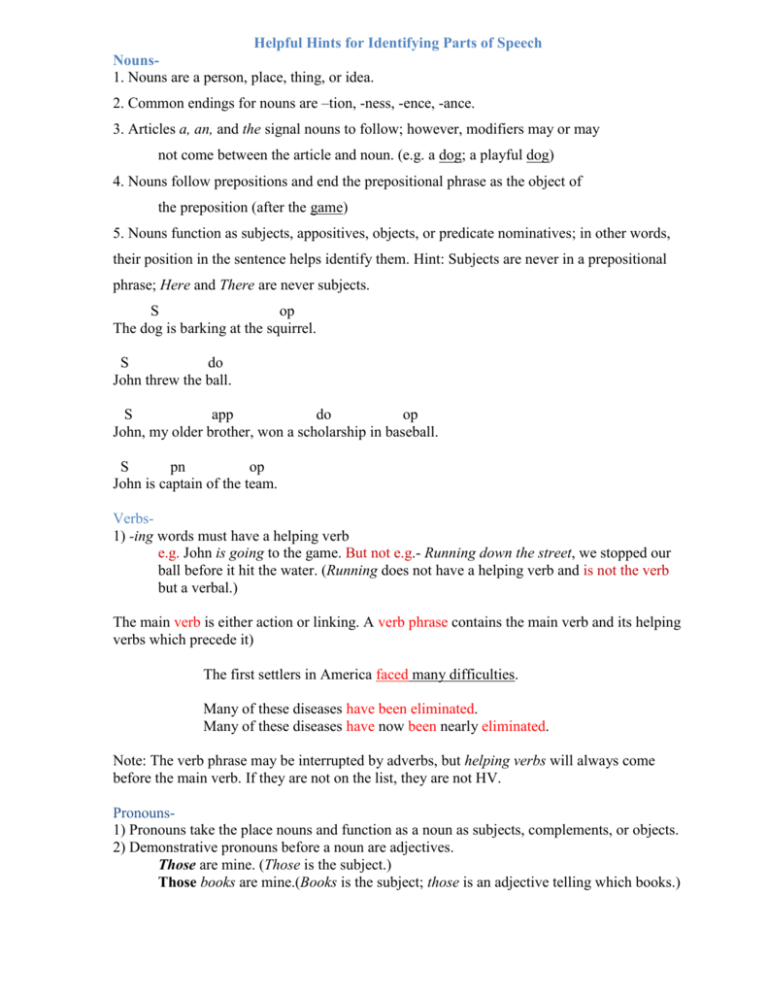
Helpful Hints for Identifying Parts of Speech Nouns1. Nouns are a person, place, thing, or idea. 2. Common endings for nouns are –tion, -ness, -ence, -ance. 3. Articles a, an, and the signal nouns to follow; however, modifiers may or may not come between the article and noun. (e.g. a dog; a playful dog) 4. Nouns follow prepositions and end the prepositional phrase as the object of the preposition (after the game) 5. Nouns function as subjects, appositives, objects, or predicate nominatives; in other words, their position in the sentence helps identify them. Hint: Subjects are never in a prepositional phrase; Here and There are never subjects. S op The dog is barking at the squirrel. S do John threw the ball. S app do op John, my older brother, won a scholarship in baseball. S pn op John is captain of the team. Verbs1) -ing words must have a helping verb e.g. John is going to the game. But not e.g.- Running down the street, we stopped our ball before it hit the water. (Running does not have a helping verb and is not the verb but a verbal.) The main verb is either action or linking. A verb phrase contains the main verb and its helping verbs which precede it) The first settlers in America faced many difficulties. Many of these diseases have been eliminated. Many of these diseases have now been nearly eliminated. Note: The verb phrase may be interrupted by adverbs, but helping verbs will always come before the main verb. If they are not on the list, they are not HV. Pronouns1) Pronouns take the place nouns and function as a noun as subjects, complements, or objects. 2) Demonstrative pronouns before a noun are adjectives. Those are mine. (Those is the subject.) Those books are mine.(Books is the subject; those is an adjective telling which books.) 3) Types of pronouns PERSONAL PRONOUNS: I, you, he, she, we, they, who, whoever, me, him, her, us, them, whom, whomever. Who is there? I am. RELATIVE PRONOUNS: who, whom, whose, which, that. Zora Neale Hurston, who wrote “Sweat,” grew up in Florida. DEMONSTRATIVE PRONOUNS: this, that, these, those These are new. (WARNING: Note here these is functioning as the subject; however, in These books are new , these is functioning as an adjective identifying books. INTENSIVE / REFLEXIVE PRONOUNS: myself, herself, himself, themselves. The manager himself checked the work. He did it himself. Adjectives 1) Adjectives modify or describe nouns and pronouns; they answer the questions which one, what kind, how much, how many, or whose about the noun. 2) Common endings are –ous, -able, -ible, -ful, -al, -less. 3) Possessives are adjectives (e.g. his, hers, its, John’s, Dickens’s, Tampa’s) 4) Adjectives generally come before the noun they modify. (e.g. John’s boots, his boots, those boots, the red boots, cowboy boots, American-made boots, two boots.) Note: proper adjectives are capitalized and are functioning as adjectives, not nouns. 5) Adjectives can be a predicate adjective (PA), in which case they come after a linking verb (am, is, are, was, were) and describe the subject. (e.g. The boy is tall. Note that you can say, The tall boy; tall describes the boy. ) 6) Adjectives can also come after nouns (The gentleman, tall and dignified, entered the room.) Note that the adjectives here are set off by commas and in twos. This is not a common position. In English, adjective do not come after nouns (NOT The boots red are by the door. BUT The red boots are by the door.) 7) If there is only one word between an article and a noun or between preposition and the object of the preposition, that word is an adjective. (e.g. a tall boy; in the dark room; Adverbs 1) Adverbs modify verbs, adjectives, and other adverbs. 2) Adverbs answer the questions when, where, how, how often, why, or to what extent. 3) Adverbs that modify verbs should be placed near the word they modify, but they may come at the beginning of the sentence, before or after the verb. 4) Adverbs that modify adjectives or other adverbs generally tell the degree or to what extent and come right before the word they modify. (e.g. He ran extremely well. The cake was very good.) 5) Adverbs often end in –ly Interjection1) Interjections are words that express strong emotion. 2) Interjections are often followed by exclamation points: Hey! Wow! Yeah! Yes, please. Well, that’s that. Conjunction1) Conjunctions are words that join words or groups of words. 2) Coordinating conjunctions (also called FANBOYS conjunctions: for, and, not, but, or, yet, so) join words, phrases, or clauses of similar kind through coordination. John and Tom are here. They left before dawn and arrived after dark. 3) Correlative conjunctions (both…and, either…or, neither…nor, not only…but also, whether…or) work together in pairs to join words or groups of words of similar kinds. My favorite athletes include not only Pirates Roberto Clemente and Willie Stargell but also Steelers Lynn Swan and Terry Bradshaw. 4) Subordinating conjunctions join a dependant clause to an independent clause (after, although, as, as if, as though, as much as, as soon as, as long as, because, before, if, in order that, lest, since, so that, than, though, unless, until, when, whenever, where, wherever, whether, while). DC IC IC DC After I finish this book, I will read the sequel. He won the contest because he prepared well. Prepositions- (see the list) 1) Prepositions show the relationship between a noun and another word in the sentence (They are often said to be anything a mouse can do with a hollow log (e.g. under the log, over the log, around the log NOTE: The relationship is between the mouse and the log.) 2) They begin prepositional phrases, which are short phrases that begin with a preposition and end with a noun or pronoun. COMMONLY USED PREPOSITIONS aboard beside off about between on above beyond over across but (except) past after by since against down through along during throughout amid except to among for toward around from under in underneath before into until behind like unto below near up beneath of upon with within without despite COMPOUND PREPOSITIONS as ---as (i.e. as long as, as well as) because of by way of on account of in spite of instead of apart from with regard to according to in---of (i.e. in front of, in lieu ofat ahead of along with in addition to

